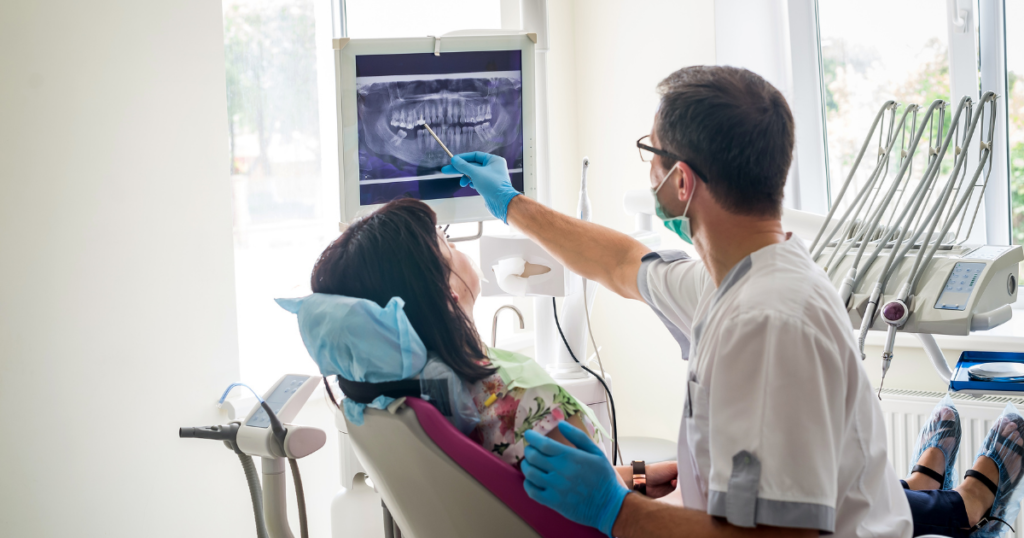Our mouths are part of our bodies, so dental care is heath care. But a limited view of what counts as health care is leaving Mainers with low incomes at risk of poor health outcomes or even health complications.
Currently, Maine’s Medicaid program, MaineCare, only covers emergency dental work for adults. Lawmakers this year are considering several bills to expand MaineCare coverage to include preventative care and routine checkups: LD 62, “An Act to Promote Cost-effectiveness in the MaineCare Program and Improve the Oral Health of Maine Adults and Children,” LD 72, “An Act to Improve Dental Health for Maine Children and Adults with Low Incomes,” and LD 996, “An Act to Improve Dental Health Access for Maine Children and Adults with Low Incomes.”
When Mainers with low incomes cannot access to affordable dental care through Medicaid, they’re more likely to put off preventative treatments and eventually receive care in the emergency room. This is not only bad for their health, but it’s more expensive for the state. In order to have healthy bodies and live full lives, Mainers need access to affordable dental care just as they need access to affordable health care of other kinds.
Dental care is essential to health and economic security, but access is highly inequitable
Studies from other states have shown that a lack of adult dental care coverage is linked with higher rates of emergency room use, more unmet need for treatment, and worse oral health outcomes.1 Similarly, where states have increased access to dental care through Medicaid, people get more routine checkups and have fewer untreated cavities.2 A lack of access to dental health care also leads to increased costs in the form of expensive complications that can result from deferred or missed treatment.
The current state of dental care in Maine is highly inequitable. Lack of access to affordable dental care means that large numbers of Mainers are going without routine checkups. While 85 percent of Mainers with annual household incomes above $75,000 have seen a dentist in the past year, the same is true of just 35 percent of Mainers in households with incomes under $20,000. The poorest Mainers are nine times as likely as the highest-earning Mainers to have gone more than five years without dental care.3 Surveys show that the overriding reason is the cost of care.4
In this context, it’s no surprise that one in five low-income Mainers reports that their mouth and teeth are in poor condition.5 The inclusion of adult dental health coverage for MaineCare patients would put an end to the status quo in which oral health is a by and large a privilege reserved for those with higher incomes.
Large numbers of Mainers feel that the condition of their mouth and teeth impact their overall happiness and their quality of life, and a lack of access to dental care is part of the poverty trap which keeps Mainers from thriving. According to a survey by the American Dental Association, one in three Maine adults say their life is less satisfying because of their poor oral health, while one in five say the appearance of their mouth and teeth make it harder to interview for a job.6 Low-income adults are even more likely to experience these problems, with more than one in three reporting that the condition of their teeth and mouth make job interviews harder.
Inequities in access to dental health care affects more than just oral health; Research shows that oral diseases can lead to other health problems, from cancer and cardiovascular disease to stroke and even preterm delivery during pregnancy7 — an important fact given that a little under half of all births in Maine are covered by MaineCare.8 Providing Maine’s Medicaid patients with access to dental benefits represents a small up-front cost to avoid larger long-term expenses.
LDs 66, 72 and 996 would correct a deficiency in our public health system. For too long we have put the health and economic security of low-income Mainers at risk by separating dental care from other forms of health care. Including dental care in MaineCare benefits will allow many Mainers access to valuable health services which will improve the quality and length of their lives, boost their employment prospects, and ultimately prevent long-term costs down the road.
Notes
[1] Neal Wallace et al., “The Individual and Program Impacts of Eliminating Medicaid Dental Benefits in the Oregon Health Plan,” American Journal of Public Health, Oct 17, 2011. Web. Available at https://ajph.aphapublications.org/doi/10.2105/AJPH.2010.300031 and Astha Singal et al., “Eliminating Medicaid Adult Dental Coverage In California Led To Increased Dental Emergency Visits And Associated Costs,” Health Affairs, May 2015. Web. Available at https://www.healthaffairs.org/doi/10.1377/hlthaff.2014.1358
[2] Sandra Decker & Brandy Lipton, “Do Medicaid benefit expansions have teeth? The effect of Medicaid adult dental coverage on the use of dental services and oral health,” Journal of Health Economics, Dec 2015, pp212-225. Available at https://doi.org/10.1016/j.jhealeco.2015.08.009 and Moonkyung Kate Choi, “The impact of Medicaid insurance coverage on dental service use,” Journal of Health Economics, Sept 2011, pp1020-1031. Available at https://www.sciencedirect.com/science/article/abs/pii/S016762961100110X
[3] MECEP analysis of US Centers for Disease Control, Behavioral Risk Factors Surveillance Survey, 2016 data.
[4] “Oral Health and Wellbeing in Maine,” American Dental Association, 2015. Web. Available at https://www.ada.org/~/media/ADA/Science%20and%20Research/HPI/OralHealthWell-Being-StateFacts/Maine-Oral-Health-Well-Being.pdf
[5] Ibid.
[6] Ibid.
[7] “2000 Surgeon General’s Report on Oral Health in America,” National Institute of Dental and Craniofacial Research. Web. Available at https://www.nidcr.nih.gov/research/data-statistics/surgeon-general and SS Hwang et al., “The association between maternal oral health experiences and risk of preterm birth in 10 states, Pregnancy Risk Assessment Monitoring System, 2004-2006,” Maternal Child Health Journal, 2012 Nov 16(8): 1688-95. Available at https://www.ncbi.nlm.nih.gov/pubmed/21847677
[8] “Births Financed by Medicaid,” Kaiser Family Foundation. Web. Available at https://www.kff.org/medicaid/state-indicator/births-financed-by-medicaid/?currentTimeframe=0&sortModel=%7B%22colId%22:%22Location%22,%22sort%22:%22asc%22%7D




